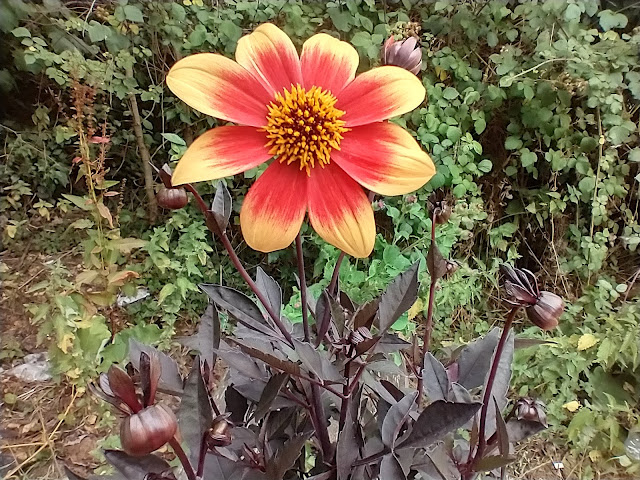Loving my lawn
The bees love it too and it turns out it's an important plant for them as Jean Vernon told me on Twitter: "...it really helps as there is a huge June gap in terms of food plants for pollinators. So good you are seeing more bees."
You may remember last year I took part in Plantlife's Every Flower Counts survey and found my little patch of lawn can support over 2,000 bees. They've now published last year's results and it shows my wild and woolly lawn approach has started to reap benefits as it supports many more bees than average. It also shows how powerful citizen science can be as they found a surprising result: flower and nectar production was higher from lawns mown every four weeks. This is because the short grass flowers like daisies, self-heal and white clover recover to flower in profusion and increase nectar production tenfold.
It means Plantlife have now changed their advice on lawn management, and suggest two heights of grass. Some areas can be kept relatively short for their nectar production (cut 4-5 times per year), combined with other areas having longer grass to boost flower diversity, which in turn encourages insect diversity... and so on. These areas should be cut at the end of summer, or early autumn. This approach can be seen in the photo above of the Donkey Field. The area is usually mown quite closely, but this year has been left mainly to nature, with mown pathways to walk through. As a result the area has exploded into life, with many more insects and birds as well as the wildflowers. I hope the town council continue with this policy, especially as the results of the recent Neighbourhood Plan consultation results show residents want more wildflowers in their townscape.
It's not just the shorter flowers which recover well from mowing. Here you can see the ox-eye daisies have also bounced back. I'm now using them as a cut flower along with the self-sown Eryngium and lemon balm which are out of shot. Georgie Newberry always advises making use of any plant material you have for cutting, so I've also made a smaller arrangement of Alchemilla and buttercups for the kitchen windowsill. All are from my lawn!
You may also like:
Jean's Vernon's The Secret Lives of Garden Bees gives a fascinating insight to these welcome garden visitors and is a great reminder that it's not just the honey bee that's important to our lives and gardens. Seek out their variety, interesting stories, and how to look after their needs in this approachable and informative volume.
If you order direct from Jean, you also get a signed copy and the opportunity for a dedication if it's a gift. NB I did have the opportunity to join Jean's blog book tour earlier this year, but the timing was all wrong due to NAH's health. Instead I've bought my copy as a present to myself as I love watching the bees in my garden. Jean's just added a lovely nugget via Twitter: "...leaving some of your lawn to flower for bees & cutting some short for mining bees is an important thing to do for solitary bees." Apparently it's Solitary Bee Week, so by serendipitous fate this post is timed perfectly for that 😊
If you order direct from Jean, you also get a signed copy and the opportunity for a dedication if it's a gift. NB I did have the opportunity to join Jean's blog book tour earlier this year, but the timing was all wrong due to NAH's health. Instead I've bought my copy as a present to myself as I love watching the bees in my garden. Jean's just added a lovely nugget via Twitter: "...leaving some of your lawn to flower for bees & cutting some short for mining bees is an important thing to do for solitary bees." Apparently it's Solitary Bee Week, so by serendipitous fate this post is timed perfectly for that 😊
PLUS news hot off today's press: The Bumblebee Trust have launched a free ID App to help you identify 8 common bumblebee species via your phone.















It's all inspiringly pretty (and interesting) - including the donkey field.
ReplyDeleteThe Donkey Field is looking even better - loads of wild geraniums in flower. You'd love it.
DeleteThat is a lawn I could learn to love.
ReplyDeleteSeveral years of benign neglect needed to get it this way Diana. It helps having a husband who mows the lawn but hates the task. It looks like we've inadvertantly been following Planflife's advice well before they issued it!
DeleteWe have self-heal growing here but it hasn't made it to the lawn yet to join all those daisies, buttercups and clover. Will look out for the book 😄
ReplyDeleteI seem to remember it was on our gravel path at first and then hopped over the brick edging. I'm pleased it did!
DeleteLovely! I've embraced what a long-ago ecologist termed "freedom lawns" for many years, even as now we have no lawn in Asheville and a minimal one (downsized) in Quebec.
ReplyDeleteOur neighbors' son, back in Quebec from his University professor job in Mississippi asked recently if we'd like to have our "lawn" moved (he claimed he enjoyed this activity). We said yes, of course, as we're not going to be able to be there anytime soon.
But, it's a "freedom lawn" there -- full of clover, etc. I don't think we have any Prunella in the lawn, aside from in a couple of bed edges, echoes from the previous gardeners.
I love the term 'Freedom Lawn' Lisa!
Delete